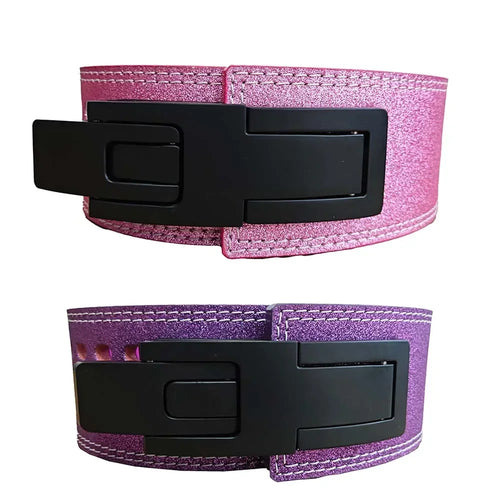Women's weightlifting belt
⭐ Meilleure vente dans cette collection
Women's Lever Belt

Combine Style and Performance for Optimal Workouts Maximize your performance and protect your back while adding a touch of style...
Voir le produitThe weightlifting belt is an essential accessory for women practicing intensive bodybuilding. It offers optimal support during strength exercises , allowing you to push your limits in complete safety. Let's discover together the essential characteristics of this equipment and how to choose the ideal model for your training sessions.
The Benefits of a Weightlifting Belt for Women
Using a weightlifting belt brings many benefits to strength sports practitioners. Its main role is to provide increased abdominal support during exercises involving heavy loads. This assistance allows you to:
- Effectively protect the lower back
- Keep the core engaged during exercise
- Promote an upright and confident posture
- Increase body stability
By wearing a suitable belt, women can push their limits with confidence . Whether for weightlifting, crosstraining or powerlifting, this accessory quickly becomes a valuable ally. It is suitable for both beginners and experienced athletes, each finding support that meets their needs.
The belt also plays an important role in injury prevention. By stabilizing the spine, it reduces the risk of bad movements that can lead to lower back pain. This additional protection allows athletes to train with more intensity and regularity , thus promoting their progress.
Choosing the ideal belt: essential criteria
When selecting the perfect weightlifting belt, there are several factors to consider. Here are the main criteria to consider:
1. Size : Belts are usually available in different sizes, ranging from XS to XL. It is vital to choose a size that fits your waist size for optimal support. A gap of 2 to 5 cm between the ends of the belt is recommended for a perfect fit.
2. Closure system : There are two main options: Velcro and steel buckle. Velcro offers quick and easy adjustment, while the steel buckle provides a more robust hold. Some models combine both systems for increased versatility.
3. Width : Most weightlifting belts have a standard height of 10 cm. This dimension offers a good compromise between support and freedom of movement. On the other hand, thinner or wider models exist to meet specific needs.
4. Material : Choose belts made of durable materials that can withstand heavy use. Leather and high-strength synthetic fabrics are the most commonly used.
To help you compare the different options, here is a summary table of the main characteristics:
| Criteria | Options | Benefits |
|---|---|---|
| Size | XS, S, M, L, XL | Precise adaptation to waist size |
| Closing | Velcro, Steel buckle, Mixed | Quick adjustment or reinforced support |
| Width | 8 cm, 10 cm, 12 cm | Balance between support and mobility |
| Material | Leather, Synthetic | Durability and resistance |
Advanced features for optimal comfort
Beyond the basics, some women's weightlifting belts offer innovative features to enhance the user experience. These advanced features include:
- The quick-release system (EasyClip): Allows you to quickly switch from a heavy exercise to a more dynamic movement without wasting time.
- The “Double Secure” function: Provides reinforced support for particularly heavy loads.
- Customizable designs: Some models offer the addition of patches to express your personal style.
- Breathable materials: Promote the evacuation of perspiration for increased comfort during intense sessions.
These additional options can make a difference in your final choice , depending on your preferences and specific needs. Don't hesitate to compare the different models to find the one that best suits your practice.
It is also important to note that some belts are designed specifically for women, with curves adapted to the female morphology. These models can offer superior comfort and better distribution of support around the waist.
Maintenance and lifespan of your belt
To get the most out of your weightlifting belt in the long run, it's important to take care of it. Here are some tips to help extend the life of your equipment :
- Clean your belt regularly with a damp cloth to remove sweat and residue.
- Avoid leaving it in a humid environment after use.
- Store flat or rolled slightly to avoid creases and warping.
- Regularly inspect the seams and closure system for signs of wear.
A quality weightlifting belt, properly maintained, can last for several years , even with intensive use. It is an investment in your health and performance that deserves your full attention.
By choosing your weightlifting belt wisely and taking care of it, you ensure reliable and long-lasting support for all your workouts . Whether you are an experienced athlete or an enthusiastic beginner, this accessory will quickly become indispensable in your quest for progress and self-improvement.













